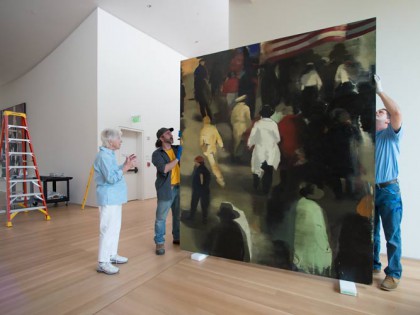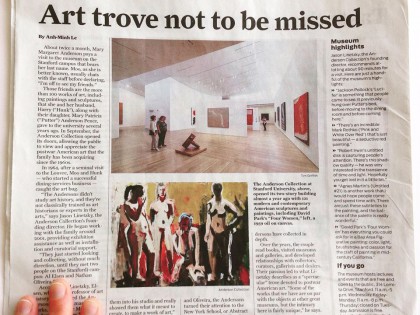To the Andersons, their art is family—and so is Stanford, its new caretaker.
September/October 2014
The Collection of a Lifetime
To the Andersons, their art is family—and so is Stanford, its new caretaker.
©Henrik Kam 2014
The striking centerpiece of the new Anderson Collection building is a grand staircase ascending to the main gallery spaces—airy, open, graced with natural light—and their cornucopia of art.
When the collection opens on September 21, visitors can experience 121 major works—paintings and sculptures—by 86 modern and contemporary American artists, the magnificent gift of Harry W. and Mary Margaret Anderson and their daughter, Mary Patricia Anderson Pence.
Designed by Richard Olcott of Ennead Architects, the 33,000-square-foot structure, adjacent to the Cantor Arts Center, includes a library, a conference room, offices and storage space.
Stanford is not the Andersons’ alma mater, but their strong ties with the university extend back half a century to their friendship with the late art professors Albert Elsen, Lorenz Eitner and Nathan Oliviera, who were instrumental in nurturing the couple’s passion for art and their eye for quality. The forthcoming collection catalogue includes a richly sourced account of the Anderson-Stanford connection by editor Molly S. Hutton, PhD ’00, with additional essays by David Cateforis, MA ’88, PhD ’92, and Evelyn C. Hankins, MA ’95, PhD ’99, former Anderson interns while Stanford graduate students.
Richard Diebenkorn
©The Richard Diebenkorn Foundation
Back when most American collectors and curators considered New York the sole fount of art, the Andersons began embracing California painters, none more so than Diebenkorn, ’44. The couple became part of his social circle and acquired more than 80 of his paintings, drawings and prints between 1969 and 1990, of which three paintings are part of their gift to Stanford. (The others are Ocean Park #60 and Girl on the Beach.) Active in the Bay Area Figuration movement, the artist moved from abstraction to figuration and back to abstraction over the course of his career.
David Park
Courtesy of Hackett/Mill, Representative of the Estate of David Park
A pioneer of the 1950s Bay Area Figuration movement, which included Richard Diebenkorn, ’44, Park reportedly took all his earlier abstract expressionist works to the Berkeley dump in 1949. Nevertheless, as former Anderson Collection intern John Seed, ’79, observed in 2012, “Somehow he made peace with abstraction, but he had to do it by putting human presence, in all its beautiful imperfection, into the forefront once again.”
pollock
©2014 The Pollock-Krasner Foundation/Artists Rights Society (ARS), New York
The Andersons purchased Lucifer in 1970. Former collection intern Neal Benezra, MA ’81, PhD ’83, director of the San Francisco Museum of Modern Art, told the L.A. Times: “What is most extraordinary in the collection is the representation of Abstract Expressionist works at a time when a museum can only dream of acquiring paintings by Pollock or de Kooning. The treasure of the collection, unquestionably, is Lucifer, by many people’s lights the outstanding drip painting still in private hands, an absolutely beautiful painting, which would make any museum’s collection sing.”
Partners in Art
The Anderson Collection is new to campus but has long served Stanford students.
By Wanda M. Corn
For the many years that I taught at Stanford, the Anderson Collection served as an informal arm of the art history programs. Harry W. (“Hunk”) and Mary Margaret (“Moo”) Anderson are the most generous of collectors and wanted the art on their walls to be used as a teaching tool. Those of us who taught modern art knew it took only a phone call to Hunk’s office to arrange a tour of the Anderson home for our classes. For me, the ideal scheduling of this tour took place near the end of the course, when students had done enough reading and writing to appreciate the breadth and uncommon beauty of the collection.
On these visits, Hunk customarily was in attendance, asking questions of the students. I would always tell them in advance to make good use of this opportunity and ask good questions of Mr. Anderson, so that they could hear for themselves the passion, discipline and hard work behind a private collection. After touring the house, we would convene in the Anderson art studio where the students sat on the floor and listened to Hunk relate his personal history as a collector and the great satisfactions he took in putting together a stellar selection of late 20th-century American art. For most of my students, this was the first time they had ever seen a major private collection in a domestic setting and met someone who could articulate what it meant to live with, learn about and love the art of their time.
I also warned them to be prepared for one of Hunk’s favorite questions: “Which major artists are not yet represented in my collection?” That was a toughie for undergraduates who usually were so dazzled with the collection that they could not fathom that there were any missing players. Hunk would inevitably have to give them the answer he was looking for: Barnett Newman.
As the Andersons’ paintings, prints and sculptures increased, filling the walls of the Saga Food home office in Menlo Park as well as their family home nearby, the collection needed management. Recognizing the mutual benefit the collection and the university could reap, Hunk began to hire Stanford’s art history doctoral students as interns, giving them the opportunity to learn the multiple skills used in museum work. In essence, the collection became an off-campus laboratory for our students, a place where they could experience and care for masterworks and gain valuable practice in handling pieces of art. Anderson interns did everything from hanging paintings to writing wall labels and catalogue essays; they inventoried works, gave tours of the collection and arranged for loans to other institutions. Some were lucky enough to accompany Hunk on a buying trip in New York City, seeing firsthand the operations of the commercial art world.
These were invaluable additions to a student’s education and résumé. Some of our doctoral students, including Neal Benezra, MA ’81, PhD ’83, director of the San Francisco Museum of Modern Art, worked with the collection for several years before moving into careers as teachers and museum professionals. Hunk willingly wrote them letters of recommendation and has always taken great pride in their later achievements.
The long history of Stanford and the Andersons working together to educate students in the arts is by no means over. It is the foundation for the new building on campus to house the collection, guaranteeing that the partnership will continue in perpetuity. Thank you, Hunk and Moo, for continuing to share your collection with all of us.
Wanda M. Corn is the Robert and Ruth Halperin Professor Emerita in Art History.






